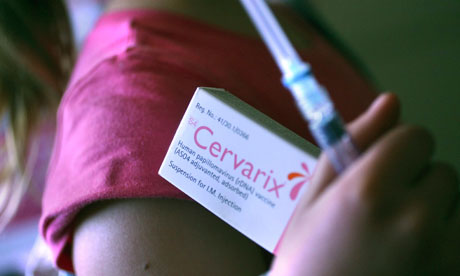
Vaccination is crucial in developing countries because so few women go for cervical cancer screening. Photograph: Loanna Hoffmann/Alamy
At age 22, all Martha Achieng' Ooko craved was freedom and a place to call her own. She was working hard as a beautician, giving manicures and pedicures in the western Kenyan city of Kisumu, saving to open her own salon one day. People who knew Ooko, the eldest of five children, believed she had what it takes to succeed.
Last December, at the age of 25, Ooko was dead. Not from a car crash, nor a complicated childbirth, and not from HIV-Aids – crises that typically claim young lives in Kenya. When doctors at Nyanza provincial hospital had first diagnosed Ooko with stage 2B cervical cancer a year earlier, her sister Joy was convinced it was a mistake.
Days after receiving the bad news, Ooko, her sister and their mother travelled to Nairobi's Kenyatta national hospital (KNH) for a second diagnosis. This time, the verdict was worse – stage 3. The family could afford treatment, and Ooko immediately began a series of six radiotherapy and two chemotherapy sessions. But it was too late. "It took less than a year from her diagnosis to her death," says 20-year-old Joy, her face still blank with disbelief and shock.
Ooko's death underlines a question for developing countries such as Kenya: how best to spend limited health resources? Non-communicable diseases such as cancer have not, in the past, been seen as a priority. Many public health specialists are saying that must change. "Every year, Kenya loses approximately 3,400 women to cervical cancer," says Dr Lucy Muchiri, a pathologist who specialises in the disease at KNH and the University of Nairobi.
Muchiri suspects that the numbers of cervical cancer fatalities are significantly higher because there is no accurate tally of cancer rates in remote rural areas. "Not everyone has access to laboratory diagnosis," she says, "so a lot of Kenyans die of disease or are being treated at home without medical diagnosis." Health advocates and researchers estimate that fewer than 5% of Kenyan women are screened for cervical cancer annually.
Fortunately, the past decade has yielded another powerful tool in the fight against cervical cancer worldwide. In 2006, the pharmaceutical company Merck released a vaccine called Gardasil, while competitor GlaxoSmithKline released the Cervarix vaccine. Both are designed to protect women from the human papillomavirus (HPV), which causes cervical cancer. By 2009, 33 developed countries had included the HPV vaccine as part of their national immunisation programmes.
According to the American National Cancer Institute, widespread vaccination has the potential to reduce deaths from cervical cancer worldwide by as much as two-thirds. In most developing countries, the cost of the vaccine has been seen as too high. But Kenya's neighbour, Rwanda, has pursued a public-private vaccine delivery strategy that demonstrates what can be done. With vaccines donated by Merck, Rwanda last year began to roll out an ambitious nationwide programme that aims to provide vaccine protection to all girls within three years.
Although some projects in Kenya offer the HPV vaccine, Kenya's national reproductive health strategic plan has addressed cervical cancer largely through the roll-out of a low-cost screening tool known as VIA (visual inspection of the cervix using ascetic acid). For the past two years, the government has aggressively trained healthcare workers to use this "see and treat model".
VIA requires no laboratory back-up. The physician manually applies ascetic acid (or vinegar) on to the cervix to allow for a better view of the surface. If lesions or abnormalities are detected, they can be treated immediately. It is a powerful screening tool, which lawmakers adopted relatively quickly.
Research among Kenyan women to find out how much they know about cervical health suggests a further challenge. A 2010 study conducted in Kisumu by the University of North Carolina-Chapel Hill found that 89% of the study population knew of cancer in general, but only 15% had heard of cervical cancer. None of the women in the study knew about the HPV vaccine.
Muchiri summarises the biggest hurdle – the need for wide-scale public awareness. "The concept of screening and annual check-ups is really not part of our vocabulary," she says. "In Kenya, you go to hospital when you're sick, you don't go to hospital to look for disease."
Arguably, the vaccine is even more crucial for women in developing than developed countries, because so few women go for screening and there is little access to medical treatment if cervical cancer is diagnosed.
Up to now, appeals to Kenyan policymakers – including targeted lobbying of women representatives – has failed to achieve provision of the HPV vaccine as part of the government's reproductive health strategy. But government agencies recently said they are beginning the process of applying for HPV vaccines to enable mass vaccination campaigns. KNH's Dr Gathari Ndirangu cautions, however, that more than acquiring vaccines is needed. Careful planning, he says, will be required to handle the HPV vaccine, which must be kept at an appropriate temperature. "Logistics for vaccines," Ndirangu says, "take up much more resources than the actual procurement."
Public education about the need for screening and vaccines could yield positive results, Muchiri believes. "Once the public owns this problem and pushes for it," she says, "then the government would be forced to implement the strategy in full."

No comments:
Post a Comment